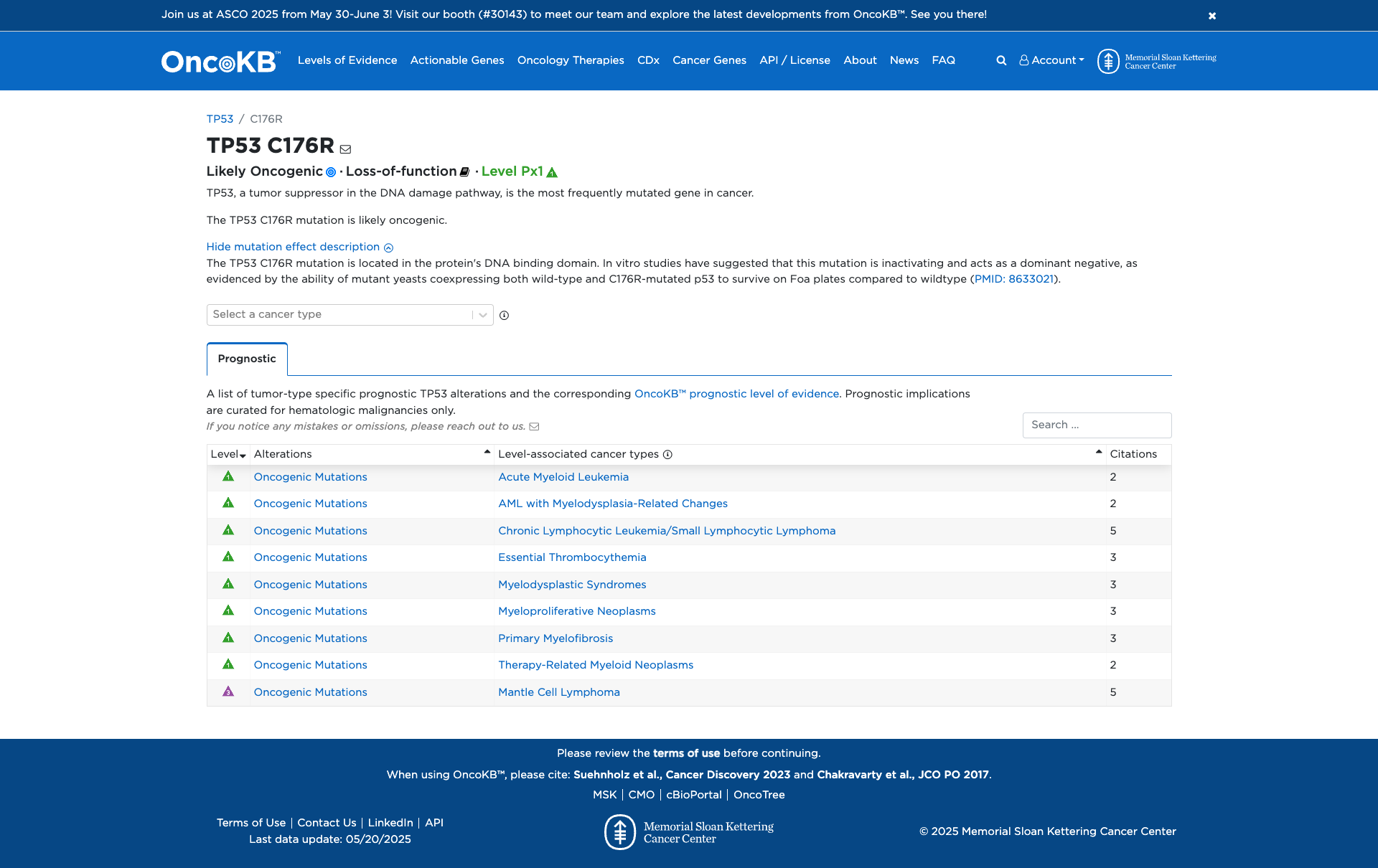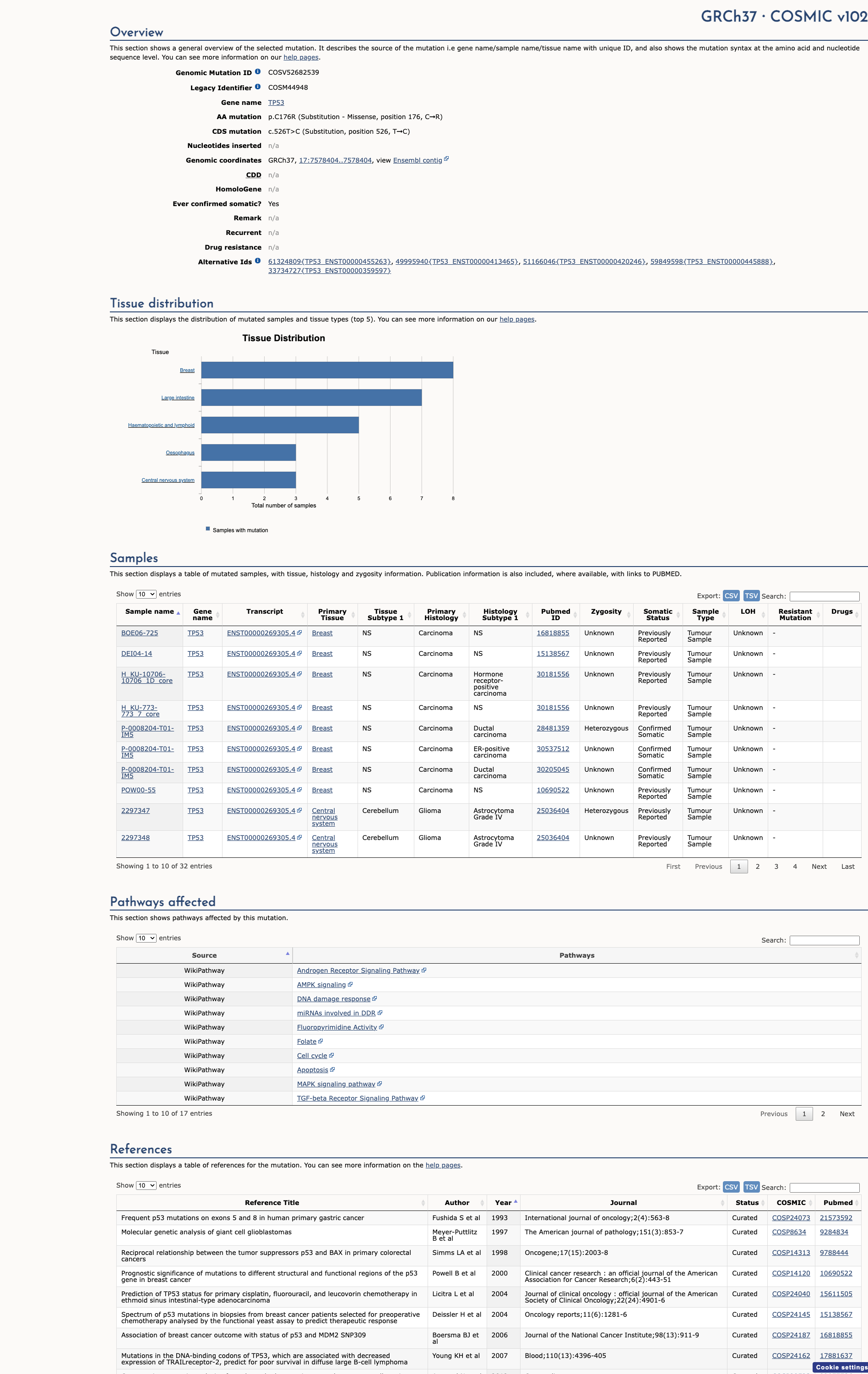TP53 c.526T>C, p.Cys176Arg
NM_000546.5:c.526T>C
COSMIC ID: COSM44948
Pathogenic
Under TP53 VCEP guidelines, only PM2_Supporting and PS3_Supporting are met; all other criteria are not applied. Insufficient evidence exists for a stronger classification, resulting in a final designation of Variant of Uncertain Significance.
ACMG/AMP Criteria Applied
PS3
PM2
Genetic Information
Gene & Transcript Details
Gene
TP53
Transcript
NM_000546.6
MANE Select
Total Exons
11
Strand
Reverse (−)
Reference Sequence
NC_000017.10
Alternative Transcripts
| ID | Status | Details |
|---|---|---|
| NM_000546.5 | RefSeq Select | 11 exons | Reverse |
| NM_000546.3 | Alternative | 11 exons | Reverse |
| NM_000546.4 | Alternative | 11 exons | Reverse |
| NM_000546.2 | Alternative | 11 exons | Reverse |
Variant Details
HGVS Notation
NM_000546.5:c.526T>C
Protein Change
C176R
Location
Exon 5
(Exon 5 of 11)
5'Exon Structure (11 total)3'
Functional Consequence
Loss of Function
Related Variants
No evidence of other pathogenic variants at position 176 in gene TP53
Alternate Identifiers
COSM44948
Variant interpretation based on transcript NM_000546.6
Genome Browser
Loading genome browser...
HGVS InputNM_000546:c.526T>C
Active Tracks
ConservationRefSeqClinVargnomAD
Navigation tips: Use mouse to drag and zoom. Click on features for details.
Clinical Data
Population Frequency
Global Frequency
0.0 in 100,000
Extremely Rare
Global: 0.0%
0%
0.05%
0.1%
1%
5%
10%+
ACMG Criteria Applied
PM2
This variant is not present in gnomAD (PM2 criteria applies).
Classification
3 publications
Likely Pathogenic
Based on 4 submitter reviews in ClinVar
Submitter Breakdown
1 Path
2 LP
1 VUS
Pathogenic
Likely Path.
VUS
Likely Benign
Benign
Publications (3)
The p.C176R variant (also known as c.526T>C), located in coding exon 4 of the TP53 gene, results from a T to C substitution at nucleotide position 526. The cysteine at codon 176 is replaced by arginine, an amino acid with highly dissimilar properties. This variant is in the DNA binding domain of the TP53 protein and is reported to have loss of transactivation capacity and a dominant negative effect in yeast based assays (IARC TP53 database; Kato S et al. Proc. Natl. Acad. Sci. USA. 2003 Jul;100:8424-9; Brachmann RK et al. Proc. Natl. Acad. Sci. U.S.A., 1996 Apr;93:4091-5; Dearth LR et al. Carcinogenesis, 2007 Feb;28:289-98). Studies conducted in human cell lines indicate this alteration is deficient at growth suppression (Kotler E et al. Mol. Cell 2018 Jul;71:178-190.e8; Giacomelli AO et al. Nat. Genet. 2018 Oct;50:1381-1387). This alteration is one of four residues necessary to bind the zinc molecule that stabilizes the beta sheet structure of the protein. Any mutation affecting these residues is predicted to prevent or destabilize zinc binding, destabilizing the structure and resulting in loss of function (Martin AC et al. Hum Mutat. 2002 Feb; 19(2):149-64). Another alteration at this same position (TP53 p.C176Y) has been identified in a patient with Li Fraumeni syndrome (Ambry internal data). This variant was not reported in population-based cohorts in the Genome Aggregation Database (gnomAD) (Lek M et al. Nature, 2016 08;536:285-91). Based on the supporting evidence, this alteration is interpreted as a disease-causing mutation.
This missense change has been observed in individual(s) with colorectal and renal tumors (PMID: 26659639). This variant is not present in population databases (gnomAD no frequency). This sequence change replaces cysteine, which is neutral and slightly polar, with arginine, which is basic and polar, at codon 176 of the TP53 protein (p.Cys176Arg). ClinVar contains an entry for this variant (Variation ID: 376573). In summary, the available evidence is currently insufficient to determine the role of this variant in disease. Therefore, it has been classified as a Variant of Uncertain Significance. Experimental studies have shown that this missense change affects TP53 function (PMID: 12826609, 29979965, 30224644). Advanced modeling performed at Invitae incorporating data from internal and/or published experimental studies (PMID: 12826609, 29979965, 30224644) indicates that this missense variant is expected to disrupt TP53 function.
This variant is considered likely pathogenic. Functional studies indicate this variant impacts protein function [PMID: 29979965]. This variant is expected to disrupt protein structure [Myriad internal data].
Clinical Statement
This variant has been reported in ClinVar as Likely pathogenic (2 clinical laboratories) and as Pathogenic (1 clinical laboratories) and as Uncertain significance (1 clinical laboratories).
COSMIC ID
COSM44948
Recurrence
32 occurrences
PM1 Criteria
Applied
Criterion PM1 is applied based on the high recurrence in COSMIC database.
COSMIC Database Preview
Accessing full COSMIC database details requires institutional login or subscription. External links may prompt for authentication.
Functional Impact
Functional Domain
Hotspot Status
Hotspot
PM1
Mutation Count
920
Reported mutations in this domain
050100+
Domain Summary
This variant is located in a mutational hotspot or critical domain (920 mutations).
PM1 criterion applied.
Related Variants in This Domain
No evidence of other pathogenic variants at position 176 in gene TP53
Functional Summary
The TP53 C176R variant has been functionally characterized in vitro, demonstrating an inactivating effect and acting as a dominant negative mutation. This is evidenced by studies showing that yeast cells coexpressing both wild-type and C176R-mutated p53 can survive under conditions that typically require functional p53, indicating a loss of normal p53 function.
Database Previews
OncoKB

JAX-CKB

Click on previews to view full database entries. External databases may require institutional access.
Computational Analysis
Pathogenicity Predictions
REVEL Score
0.94
0.94
Likely Benign0.0
Uncertain (Low)0.2
Uncertain (Med)0.5
Likely Pathogenic0.75
REVEL scores ≥ 0.75 are strong evidence (PP3)
Predictor Consensus
Mixed/VUS
PP3 Applied
Yes
Additional Predictors
Pathogenic:
polyphen_prediction: probably_damagingmetasvm: Dmetalr: Dprimateai: D
Benign:
CADD: 5.46
Neutral: Show all
VCEP Guidelines
Applied ACMG/AMP Criteria (VCEP Specific) VCEP Guidelines
PVS1
PVS1 (Not Applied) Strength Modified
According to VCEP guidelines: 'PVS1 applies to null variants (nonsense, frameshift, canonical ±1,2 splice sites, etc.) predicted to undergo NMD or critical domain disruption.' The variant is a missense substitution (C176R), not a null variant. Therefore, PVS1 is not applied.
PS1
PS1 (Not Applied) Strength Modified
According to VCEP guidelines: 'PS1 Strong: same amino acid change as a previously established pathogenic variant.' There is no record of a prior pathogenic C176R call. Therefore, PS1 is not applied.
PS2
PS2 (Not Applied) Strength Modified
According to VCEP guidelines: 'PS2 Very Strong: ≥8 de novo points; Strong: 4–7 points; Moderate: 2–3 points; Supporting: 1 point.' No parental or de novo data are provided. Therefore, PS2 is not applied.
PS3
PS3 (Supporting) Strength Modified
According to VCEP guidelines: 'If no Kato et al. data is available: LOF on Kotler et al. data AND LOF (or no data available) on Giacomelli et al. data. PS3_Supporting may also be applied to small deletions with available Kotler et al. data that demonstrates LOF.' The evidence shows well-established in vitro functional studies demonstrating an inactivating (loss-of-function) effect. Therefore, PS3 is applied at Supporting strength.
PS4
PS4 (Not Applied) Strength Modified
According to VCEP guidelines: 'PS4 Very Strong: ≥8 proband points; Strong: 4–7.5 points; Moderate: 2–3.5 points; Supporting: 1–1.5 points.' No case or proband data are provided. Therefore, PS4 is not applied.
PM1
PM1 (Not Applied) Strength Modified
According to VCEP guidelines: 'PM1 Moderate: missense variants within TP53 codons 175, 245, 248, 249, 273, or 282 are hotspots.' Codon 176 is not listed among these VCEP-defined hotspots. Therefore, PM1 is not applied.
PM2
PM2 (Supporting) Strength Modified
According to VCEP guidelines: 'PM2 Supporting: allele frequency <0.00003 in gnomAD.' The variant is absent from gnomAD (0%). Therefore, PM2 is applied at Supporting strength.
PM3
PM3 (Not Applied) Strength Modified
According to VCEP guidelines: 'PM3 applies to recessive disorders requiring evidence of trans configuration with a pathogenic variant.' TP53 disease mechanism is dominant and no allelic phase data are provided. Therefore, PM3 is not applied.
PM4
PM4 (Not Applied) Strength Modified
According to standard ACMG guidelines: 'PM4 Moderate: protein length changes due to in‐frame indels or stop‐loss variants.' This variant is a missense substitution without alteration of protein length. Therefore, PM4 is not applied.
PM5
PM5 (Not Applied) Strength Modified
According to VCEP guidelines: 'PM5 Strong: ≥2 different pathogenic missense variants at the same residue; Moderate: ≥1.' No other pathogenic missense variants at codon 176 are documented by VCEP. Therefore, PM5 is not applied.
PM6
PM6 (Not Applied) Strength Modified
According to standard ACMG guidelines: 'PM6 Supporting: assumed de novo without confirmation of paternity/maternity.' No de novo data are provided. Therefore, PM6 is not applied.
PP1
PP1 (Not Applied) Strength Modified
According to VCEP guidelines: 'PP1 Supporting: 3–4 meioses; Moderate: 5–6; Strong: ≥7 cosegregation meioses.' No family segregation data are provided. Therefore, PP1 is not applied.
PP2
PP2 (Not Applied) Strength Modified
According to standard ACMG guidelines: 'PP2 Supporting: missense variant in a gene with low rate of benign missense and where missense is a common mechanism.' TP53 has both benign and pathogenic missense variants and missense is a known mechanism—PP2 is not appropriate. Therefore, PP2 is not applied.
PP3
PP3 (Not Applied) Strength Modified
According to VCEP guidelines: 'PP3 Moderate: aGVGD Class C65 AND BayesDel score ≥0.16.' No aGVGD/BayesDel data are reported. Therefore, PP3 is not applied.
PP4
PP4 (Not Applied) Strength Modified
According to VCEP guidelines: 'PP4: phenotype specificity (e.g., LFS cancer type) with ≥2 observations.' No clinical phenotype or tumor type data are provided. Therefore, PP4 is not applied.
BA1
BA1 (Not Applied) Strength Modified
According to VCEP guidelines: 'BA1 Stand Alone: allele frequency ≥0.001 in gnomAD subpopulations.' The variant is absent from population databases. Therefore, BA1 is not applied.
BS1
BS1 (Not Applied) Strength Modified
According to VCEP guidelines: 'BS1 Strong: filtering allele frequency ≥0.0003 but <0.001.' The variant is absent from gnomAD. Therefore, BS1 is not applied.
BS2
BS2 (Not Applied) Strength Modified
According to VCEP guidelines: 'BS2 Strong: ≥8 unaffected females ≥60 years without cancer.' No such data are available. Therefore, BS2 is not applied.
BS3
BS3 (Not Applied) Strength Modified
According to VCEP guidelines: 'BS3 Strong: functional studies show no loss of function.' Functional evidence demonstrates loss of function. Therefore, BS3 is not applied.
BS4
BS4 (Not Applied) Strength Modified
According to VCEP guidelines: 'BS4 Strong: lack of segregation in affected family members.' No segregation data are provided. Therefore, BS4 is not applied.
BP1
BP1 (Not Applied) Strength Modified
According to standard ACMG guidelines: 'BP1 Supporting: missense variant in a gene where only truncating variants cause disease.' TP53 has known pathogenic missense variants. Therefore, BP1 is not applied.
BP2
BP2 (Not Applied) Strength Modified
According to standard ACMG guidelines: 'BP2 Supporting: observed in cis with a pathogenic variant.' No compound cis data are reported. Therefore, BP2 is not applied.
BP3
BP3 (Not Applied) Strength Modified
According to standard ACMG guidelines: 'BP3 Supporting: in-frame indels in repetitive regions without functional impact.' This variant is a missense substitution. Therefore, BP3 is not applied.
BP4
BP4 (Not Applied) Strength Modified
According to VCEP guidelines: 'BP4 Supporting: BayesDel <0.16 and SpliceAI <0.2.' Computational data support deleterious effect. Therefore, BP4 is not applied.
BP5
BP5 (Not Applied) Strength Modified
According to standard ACMG guidelines: 'BP5 Supporting: variant found in a case with an alternate molecular cause of disease.' No alternate cause is reported. Therefore, BP5 is not applied.
BP6
BP6 (Not Applied) Strength Modified
According to standard ACMG guidelines: 'BP6 Supporting: reputable source reports benign without available evidence.' No such benign report exists. Therefore, BP6 is not applied.
BP7
BP7 (Not Applied) Strength Modified
According to VCEP guidelines: 'BP7 Supporting: synonymous or intronic variants outside core splice motifs with SpliceAI ≤0.1.' This is a missense variant. Therefore, BP7 is not applied.

